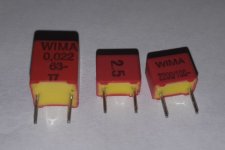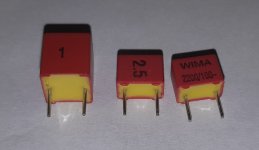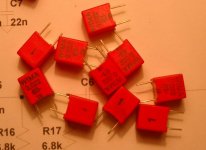Thank you, Jan. Well said!
I contend that it matters little what label is used--- dbC, dBr, or dB with no indicated reference; these are only mental aids to linking to the paramount metric: Where is the reference signal taken in the measurement setup and what is its amplitude? This should always be effortlessly discovered if the reported data is to have any value.
I'll attempt another way of emphasizing this point and illustrating that DUT gain doesn't matter, at least in principal. Assume a perfect generator and a perfect analyzer--- no residual distortion and no noise. All distortion and noise is generated within the DUT and is characterized at a specified level at its output terminals. This the reference in the reported THD ratio. The DUT gain governs only what generator amplitude is required to drive the DUT to the specified output level. The output level at the DUT is the only thing that matters.
In real instrumentation, DUT gain can be an issue, but only to the extent real residuals intrude upon the measured results.
I contend that it matters little what label is used--- dbC, dBr, or dB with no indicated reference; these are only mental aids to linking to the paramount metric: Where is the reference signal taken in the measurement setup and what is its amplitude? This should always be effortlessly discovered if the reported data is to have any value.
I'll attempt another way of emphasizing this point and illustrating that DUT gain doesn't matter, at least in principal. Assume a perfect generator and a perfect analyzer--- no residual distortion and no noise. All distortion and noise is generated within the DUT and is characterized at a specified level at its output terminals. This the reference in the reported THD ratio. The DUT gain governs only what generator amplitude is required to drive the DUT to the specified output level. The output level at the DUT is the only thing that matters.
In real instrumentation, DUT gain can be an issue, but only to the extent real residuals intrude upon the measured results.
dBm is for power, not for voltage? 0 dBm is 1 mW.Yes, that is the difference between RF and audio. Since we will generally talk about audio here, I used the audio-related definition.
dBm - Wikipedia
0 dBW is 1 W.
So I think better not use dBm, but dBu instead, if somebody wants.
In addition to Jan's posted de3finition of dBu, I would like to add the origin of such voltage and power equivalent.
Once upon a time there was a TV, radio and recording studio standard which stated that 0dB of audio power shall mean the voltage at which 1mW dissipated into a 600 ohm resistor . 1mW dissipated into 600 ohm is: 1mW = V^2 / 600.
V = sqrt(1mW*600) = 0.77459668Vrms.
Compare this with Jan's voltage value from post 7855.
This is where it comes from.
Once upon a time there was a TV, radio and recording studio standard which stated that 0dB of audio power shall mean the voltage at which 1mW dissipated into a 600 ohm resistor . 1mW dissipated into 600 ohm is: 1mW = V^2 / 600.
V = sqrt(1mW*600) = 0.77459668Vrms.
Compare this with Jan's voltage value from post 7855.
This is where it comes from.
I think any discussion of RF here is far far outside the scope of audio. The two don't compare at all. I work in broadband RF which means multiple signals over multiple channels in a BW ranging for 5MHz to 1000MHz. Distortion is not expressed the same as it involves many channels. Saturation in RF amplifiers is not voltage related voltage but is in bandwidth power. So forget it. It simply doesn't compare.
It seems my FM tuner makes audio quiet well. It requires a certain RF level to make a measurable audio signal level. All relative imo. The frequency is not the issue here, it is the methods of measurements which are important RF or audio, it really does not matter to me. Bringing up RF amp saturation, limiting etc, is now taking this measurement conversation into the ether.
My passive 1K Twin-T notch filter based on Victor's schematic. (I got pcb yesterday, in evening assembled and measured)
Simulated depth 75dB, measured 58dB.
See attached document for more
LKA, I was looking for parts for this, but I can't find the FKP with 1% tol. Best I see is 2.5%.
Where did you get yours?
Jan
Jan,
You have email.
PS WIMA select their caps.
If you buy 2.5%, you will have zero chance of getting anything within 1%, as they are all sorted out.
So 2.5% means 1.1~2.5%
5% means 2.6~5%
10% means 5.1%~10%, etc.
And 1% is VERY expensive.
Cheers,
Patrick
You have email.
PS WIMA select their caps.
If you buy 2.5%, you will have zero chance of getting anything within 1%, as they are all sorted out.
So 2.5% means 1.1~2.5%
5% means 2.6~5%
10% means 5.1%~10%, etc.
And 1% is VERY expensive.
Cheers,
Patrick
Yes I can understand that. I need only a few so price not a big factor.
Thanks for your info via email.
Jan
Thanks for your info via email.
Jan
LKA, I was looking for parts for this, but I can't find the FKP with 1% tol. Best I see is 2.5%.
Where did you get yours?
Jan
5x Capacitor 22nF, 63V, 1%, FKP2 WIMA | eBay
for 10k notch I bought 2.2nF 2.5%
Last edited:
Are they really 1%? Seems very cheap ...
Jan
I think yes. I had five 22nF 1%, one left. Number on the backside signifies the tolerance.
Attachments
Jan when I bought caps for my SVO, Dick Moore sent me and impedance bridge to match them. I had only a small sample to works with. To my surprise they all matched to 0.01% from part to part. I didn't check for closeness to nominal but if your part to part tolerance is what matters then from a batch they may be very close already.
Sold out! 1% WIMA costs 2-3 € from a prof. distributor. Here 30 cents. Very strange. Probably the trader has acquired a large position and added little profit.
Jan when I bought caps for my SVO, Dick Moore sent me and impedance bridge to match them. I had only a small sample to works with. To my surprise they all matched to 0.01% from part to part. I didn't check for closeness to nominal but if your part to part tolerance is what matters then from a batch they may be very close already.
Yes that could well be. I can measure capacitance to 0.1% absolute, 0.01% matching, which will do.
Jan
Sold out! 1% WIMA costs 2-3 € from a prof. distributor. Here 30 cents. Very strange. Probably the trader has acquired a large position and added little profit.
That should tell you how many lurkers there are here!
Jan
What about NP0? They are much cheaper and smaller then film, and it is easy to get needed nominal (in parallel). I am only not very sure about NP0 stability (but it have to be ok?).
- Home
- Design & Build
- Equipment & Tools
- Low-distortion Audio-range Oscillator



